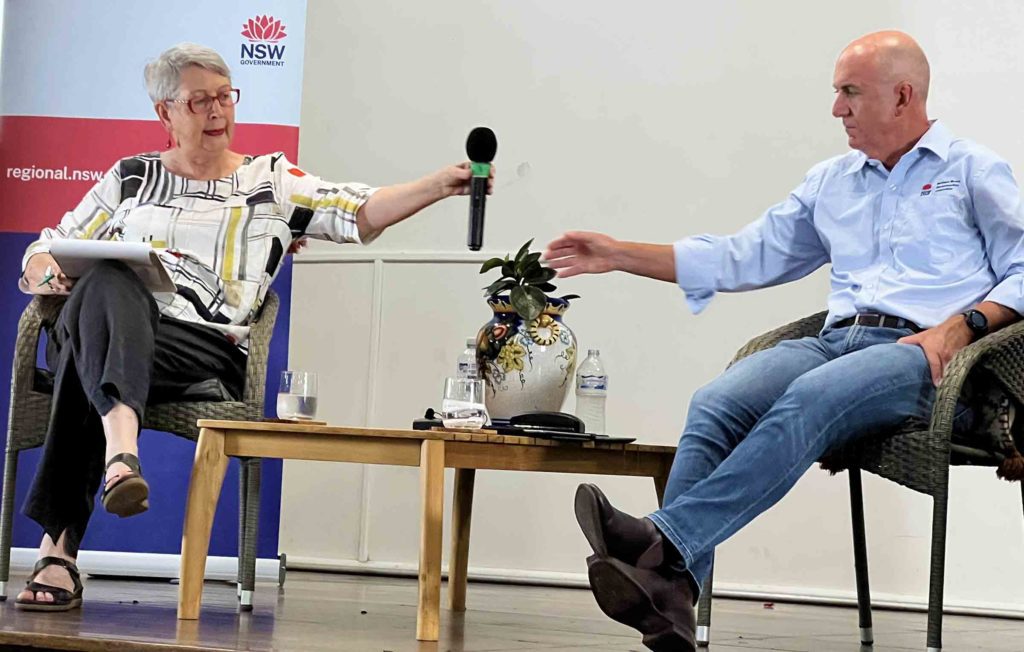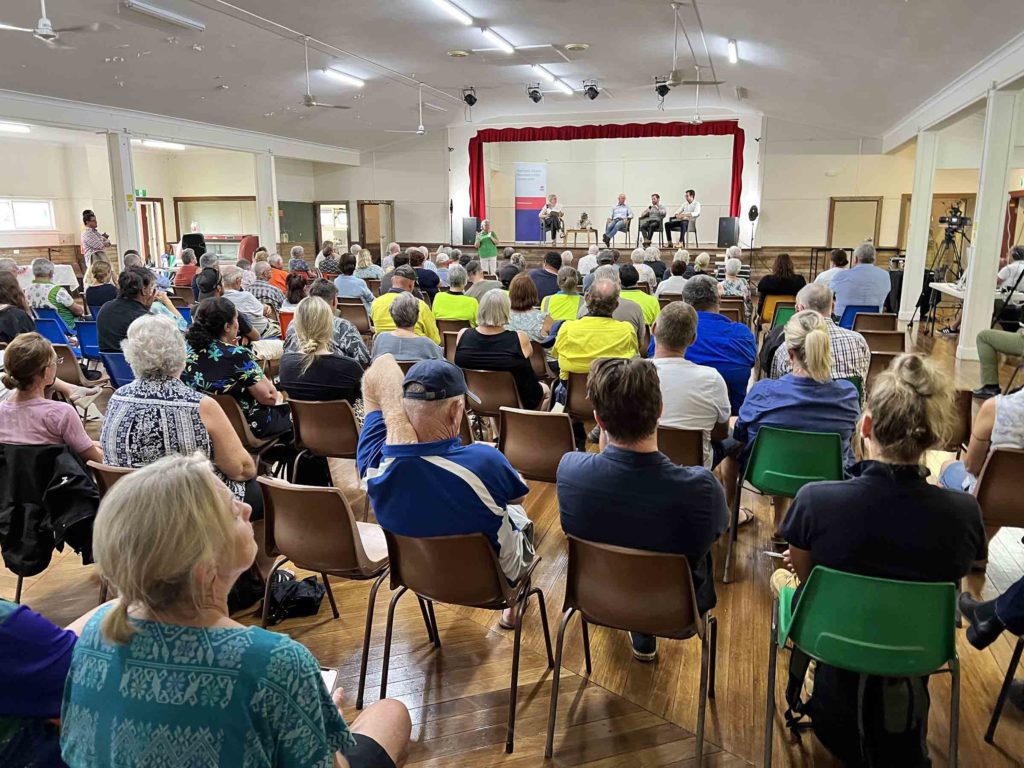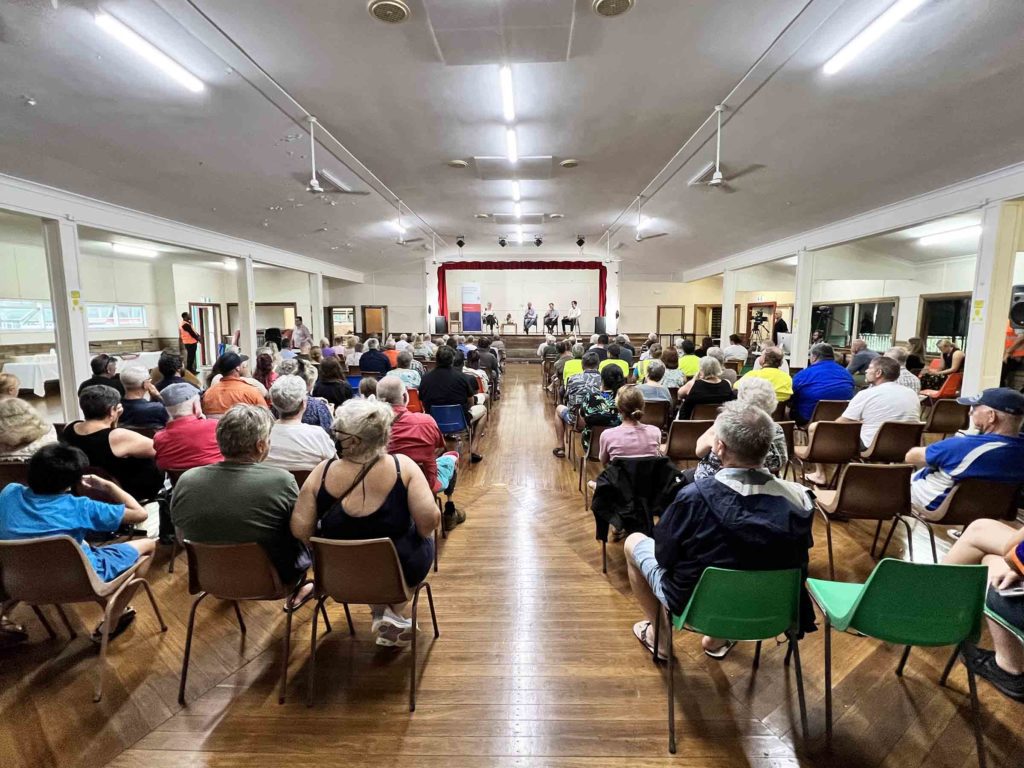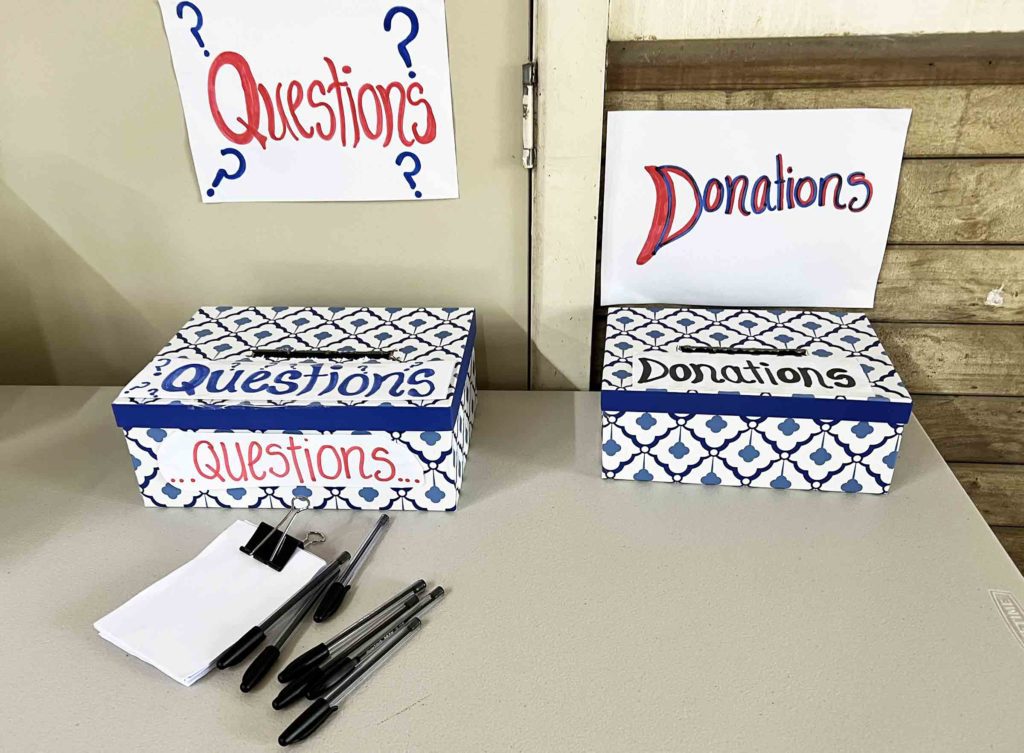ABOVE: Jenny Dowell interviews David Witherdin, Gareth Jones and Keiron Hendicott from the Northern Rivers Reconstruction Corporation on stage at Woodburn Memorial Hall.
Susanna Freymark
There were expectations, when the Woodburn community first had the opportunity to ask the Northern Rivers Reconstruction Corporation about housing.
The 170 people at Woodburn Memorial Hall on Tuesday night, January 31 had expectations that chief executive David Witherdin would provide answers about buybacks, house raising and retrofits for their flood-damaged homes.
The meeting was hosted by the resident-run Northern Rivers Flood Action Group and facilitated by former Lismore mayor Jenny Dowell.
On stage with her were Mr Witherdin, director of programs Gareth Jones and director of strategy Kieron Hendicott.
The meeting provided some detail – more than has been received since the corporation was set up in July 1.
However, the progress of the NRRC has been slow – with only 25 properties assessed for assistance out of 8000 applications.
Out of a funding pool of $700million for buybacks, house raising and resilient retrofitting, 2000 homes will be eligible for each category. That’s 6000 homes.
Mr Witherdin started the meeting with a summary of the corporation’s progress.
“We cover seven LGAs and 6000 homes will be eligible across the Northern Rivers for buyback, house raising and resilient retrofitting,” he said.
“With more than 8000 applications, we are already over-subscribed.
“Our focus is the places that are highest risk.
“We’ve done independent valuations on 25 homes.
“Next week we will make offers to those 25 homes for voluntary purchase.”
We’ve got an enormous program of work ahead of us, Mr Witherdin said.

Ms Dowell asked her questions:
The community is frustrated by the lack of communication. Do you have staff in place to deliver the communication?
Witherdin: As a team of people we are frustrated by the quality of our website. (The website was updated yesterday, January 31.)
There will be a fortnightly update on voluntary purchases and more detail on the programs online.
Dowell: 6000 homes, 25 valuations – does not sound very good. What is your timeline? When will assessments be done?
Witherdin: We knew it would be a slow start. We’ve ironed out the bugs (in the pilot program) and it will accelerate.
Jones: We have 25 individuals doing case management. We are looking to ramp that number up.
Dowell: Why is there no phone number? Have you considered a team on the phone?
Witherdin: We have focused on case managers. We have considered a hotline. We’re getting value out of community pop-ups.
Dowell: Why aren’t we seeing maps? How is it decided who will get voluntary buybacks and house raising?
Jones: It is a detailed, sophisticated process. Determining what stream someone goes into is – how often an area floods and flood heights and flood velocity. Overlaid on top of that is location risk and escape routes. Other factors include is the person mobility impaired?
On valuations for buybacks, we will offer pre-flood market offers. We get two valuations for each property. It is a rigorous process and we are looking to streamline that process.
Dowell: What is the length of time of these valuations?
Jones: You make an application on the website and a case manager will call you. We send a customer information form to you for information about the property. We book a valuation. We talk through the offer with the person and then send a letter of offer. It is a six to eight-week process.
Dowell: People believe the focus is on Lismore. Are people in the lower river included?
Witherdin: The program isn’t just Lismore focused. Some of the homes that are high risk are on the Tweed. It shouldn’t be Lismore-centric.
We don’t want to rush people into a decision. We have $700million for the program It’s going to take five years and another $700million will be required.

Dowell: Will house raising take into account the age of the residents?
Jones: We will look at personal circumstances. We look at the risk rather than the age.
Dowell: And what about land availability? I’ve heard rumours of 100 applications.
Hendicott: We had 300 applications about land availability. (Applications close today, February 1). We will make a shortlist, 50% of the 300 applications are from Lismore.
Dowell: What about home relocation, such as an old Queenslander home?
Witherdin: We’re very supportive of that. The bones of some old homes have recovered very well. It’s good if we can keep housing stock. We’re happy for that home to be moved at the owner’s cost. If they don’t want to do that, we will offer it to the market.
The tenure of the land (vacated) will change so it can’t be built on again.

Dowell: There is a terrible shortage of building materials and tradespeople. Trying to get a tradie in the Northern Rivers is almost impossible.
Witherdin: There is absolutely a housing crisis here. The construction market is running super hot.
Jones: If people don’t want to be part of the build (such as house raising), we will do it for them.
Witherdin: A development application is needed. We are compiling a DA pathway which will be in place in Lismore next week to make it less expensive.
Dowell: Is there a guide for homeowners? Will receipts be needed for work? Can they retro-claim for retrofitting?
Jones: The guide will be available any day now. If it’s a retrofit with a grant of $50,000 and $60,000 is spent, the extra is split and the owner pays $5000.
We will reimburse on retrofits done – with receipts.
Dowell: What about shonky tradies?
Jones: If you come through our system all tradies will be vetted. If you’re doing it yourself, rely on Fair Trading.

Dowell: What happens to the whole process if an elderly homeowner dies through this process? Are all bets off?
Jones: It continues and goes to the executor.
Dowell: Coming up to the anniversary, people are struggling. The most difficult time for people’s mental health is 12–18 months after the event. How will the corporation manage people’s wellbeing?
Witherdin: This is beyond our remit. Everything we do in our program of work is about people. Our role is to connect people. All of our staff have been through specific training on trauma.
Dowell: How does a person contact the corporation?
Witherdin: Through email info@nrrc.nsw.gov.au and the community pop-ups. The details are on the website.
Mr Witherdin gave a summary at the end of the meeting.
“We are bringing our very best to this. I understand your frustration at the pace at which we are moving. We will share information with the community.
”I’m optimistic by the middle of the year people will have a good idea of what options are available for them and we will be well underway.
“We will do better with communication.”
People can make decisions when they have information. This is a long process and if there is poor quality information, it makes it harder.
Jenny Dowell
A video recording of the meeting with captions will be on the Northern Rivers Flood Action Group Facebook page in a few days.
Go to the Northern Rivers Reconstruction Corporation website.
Email the corporation at info@nrrc.nsw.gov.au
If you have a story to share about your buyback, house raising or retrofit journey contact us at indynr.com@gmail.com




